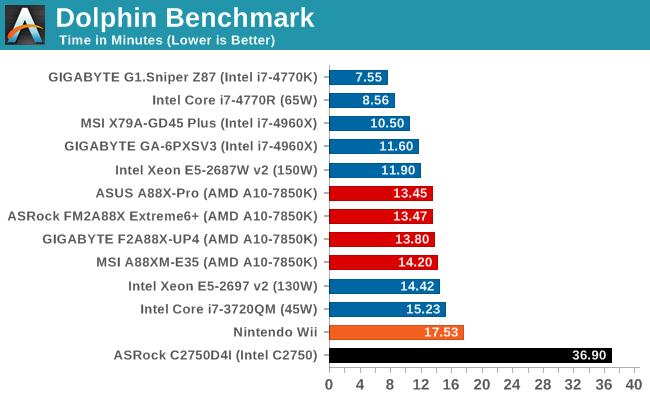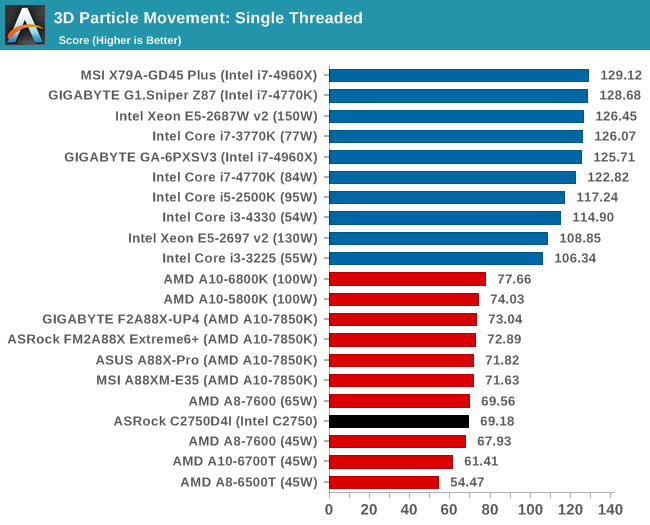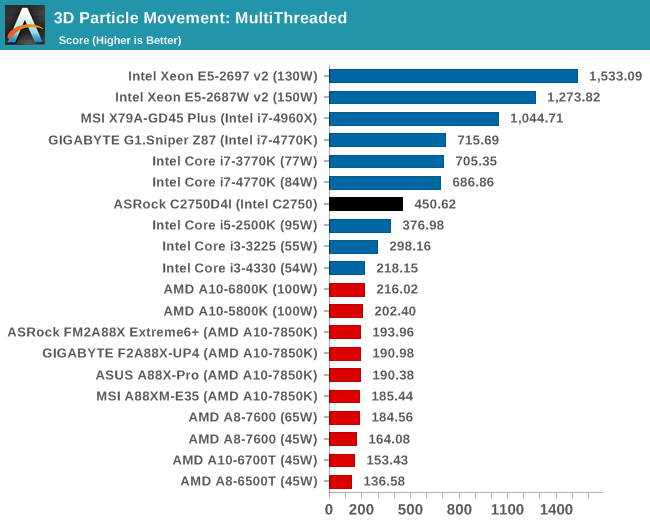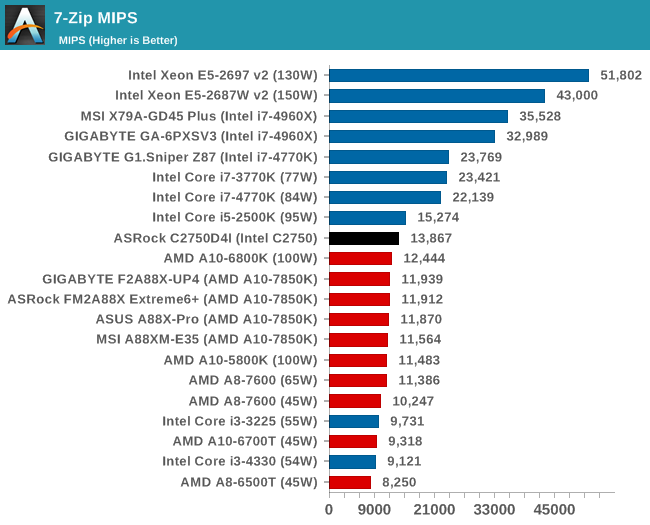ASRock Rack C2750D4I Review: A Storage Motherboard with Management
by Ian Cutress on April 29, 2014 9:00 AM EST- Posted in
- Motherboards
- Storage
- Atom
- ASRock
- Silvermont
- Enterprise
- server
- Avoton
Scientific and Synthetic Benchmarks
2D to 3D Rendering –Agisoft PhotoScan v1.0: link
Agisoft Photoscan creates 3D models from 2D images, a process which is very computationally expensive. The algorithm is split into four distinct phases, and different phases of the model reconstruction require either fast memory, fast IPC, more cores, or even OpenCL compute devices to hand. Agisoft supplied us with a special version of the software to script the process, where we take 50 images of a stately home and convert it into a medium quality model. This benchmark typically takes around 15-20 minutes on a high end PC on the CPU alone, with GPUs reducing the time.

Console Emulation –Dolphin Benchmark: link
At the start of 2014 I was emailed with a link to a new emulation benchmark based on the Dolphin Emulator. The issue with emulators tends to be two-fold: game licensing and raw CPU power required for the emulation. As a result, many emulators are often bound by single thread CPU performance, and general reports tended to suggest that Haswell provided a significant post to emulator performance. This benchmark runs a Wii program that raytraces a complex 3D scene inside the Dolphin Wii emulator. Performance on this benchmark is a good proxy of the speed of Dolphin CPU emulation, which is an intensive single core task using most aspects of a CPU. Results are given in minutes, where the Wii itself scores 17.53; meaning that anything above this is faster than an actual Wii for processing Wii code, albeit emulated.

Emulation is clearly not a target for Avoton.
Point Calculations – 3D Movement Algorithm Test: link
3DPM is a self-penned benchmark, taking basic 3D movement algorithms used in Brownian Motion simulations and testing them for speed. High floating point performance, MHz and IPC wins in the single thread version, whereas the multithread version has to handle the threads and loves more cores.


As the 3DPM test abuses the ability for a CPU to dispatch threads and FP calculations, Intel have historically been good here. The CPU battles with AMD in single threaded, but the 8 cores allows software to exploit parallelism in this manner.
Encryption –TrueCrypt v0.7.1a: link
TrueCrypt is an off the shelf open source encryption tool for files and folders. For our test we run the benchmark mode using a 1GB buffer and take the mean result from AES encryption.

For AES software encryption, the Avoton platform enjoys the 8 cores but suffers from a lack of hardware acceleration, putting it in the region of the AMD CPUs.
Synthetic – 7-Zip 9.2: link
As an open source compression tool, 7-Zip is a popular tool for making sets of files easier to handle and transfer. The software offers up its own benchmark, to which we report the result.











85 Comments
View All Comments
Marquis - Tuesday, April 29, 2014 - link
Nevermind, reading comprehension FTW. The other two are mentioned later....bombshelter - Tuesday, April 29, 2014 - link
Your comment about the reason for using the PLX switch is wrong. First, the PEX8608 is an 8-lane switch and they are using it in a x4 (from CPU) to 4 x1s (to PCIe end-points) topology. The Avoton CPU actually has a total of 16 PCIe lanes, but can only bifurcate to 4 controllers. So the real reason they are using the PLX switch is to be able to have more than 4 PCIe end-points connected to the CPU. There will be no performance degradation or sharing of bandwidth due to the presence of the PLX switch since there is an equal number of lanes going into it from the CPU as as there are end-points connected on the downstream side.Ian Cutress - Tuesday, April 29, 2014 - link
Aha, yes my interpretation of the chipset diagram was a little off. Going to update the review.chang3d - Tuesday, April 29, 2014 - link
Supermicro has two similar board with a few differences of SO-DIMM, USB 3, 4 NICs, and 6 sata headers. It's also cheaper. I think the features of this board is much better than this ASRock board.http://www.newegg.com/Product/Product.aspx?Item=N8...
ddriver - Tuesday, April 29, 2014 - link
Is it just me or was this review an extremely bad match to that product? What about NAS performance, which undoubtedly will be one of the major selling points? Instead we get gaming on a product as far from gaming as it gets. And content creation?Ian Cutress - Tuesday, April 29, 2014 - link
According to users on several forums, this board has been the focus of many different types of build. I've done a brief analysis here of usability and interface, but Ganesh is our storage guru and has all the equipment for storage related tests, so I'd rather leave that in his court for a follow-up review rather than fumble through them myself.ddriver - Wednesday, April 30, 2014 - link
No offense, but you have reviewed a rake as a back scratcher :)With such massive storage capacity, dual gigabit onboard, up to 64 GB of ECC ram - computational performance is irrelevant, this product is all about throughput. While it may be viewed as somewhat beneficial to get concrete numbers, yet after all the numbers only confirm this product ain't neither about gaming nor about content creation, so if anything the review is useful at proving its uselessness, which makes it technically useful - which is quite a nice paradox ;)
LastQuark - Monday, May 5, 2014 - link
It's not you. This is perfect to me for what this board is intended for - virtualization, NAS, home web server, backup, even good enough for a Plex or XMBC server. The review made it seem like it is for HTPC and gaming which it is not.DuckieHo - Tuesday, April 29, 2014 - link
Drop the AST2300 for management.Drop BMC/SMB.
Drop IPMB.
Drop TPM.
Drop COM port.
Reduce fan ports (6 PWM to 4 PWM).
Drop a SATA controller (12 ports to 8 or 10).
Increase the size of the heatsink and/or add a fan.
Drop the price in half for a consumer version please!
Rick83 - Tuesday, April 29, 2014 - link
There's a quad-core version of the same board at 3/4 the price. That should be enough for most home users. It's also a 14W part, so has less cooling needs.